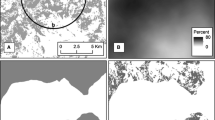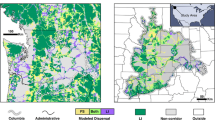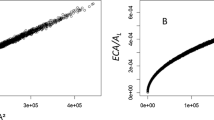Abstract
The focus of biodiversity conservation is shifting to larger spatial scales in response to habitat fragmentation and the need to integrate multiple landscape objectives. Conservation strategies increasingly incorporate measures to combat fragmentation such as ecological networks. These are often based on assessment of landscape structure but such approaches fail to capitalise on the potential offered by more ecologically robust assessments of landscape function and connectivity. In this paper, we describe a modelling approach to identifying functional habitat networks and demonstrate its application to a fragmented landscape where policy initiatives seek to improve conditions for woodland biodiversity including increasing woodland cover. Functional habitat networks were defined by identifying suitable habitat and by modelling connectivity using least-cost approaches to account for matrix permeability. Generic focal species (GFS) profiles were developed, in consultation with stakeholders, to represent species with high and moderate sensitivity to fragmentation. We demonstrated how this form of analysis can be used to aid the spatial targeting of conservation actions. This ‘targeted’ action scenario was tested for effectiveness against comparable scenarios, which were based on random and clumped actions within the same landscape. We tested effectiveness using structural metrics, network-based metrics and a published functional connectivity indicator. Targeting actions within networks resulted in the highest mean woodland area and highest connectivity indicator value. Our approach provides an assessment of landscape function by recognising the importance of the landscape matrix. It provides a framework for the targeting and evaluation of alternative conservation options, offering a pragmatic, ecologically-robust solution to a current need in applied landscape ecology.





Similar content being viewed by others
References
Adriaensen F, Chardon JP, De Blust G, Swinnen E, Villalba S, Gulinck H, Matthysen E (2003) The application of ‘least-cost’ modelling as a functional landscape model. Landsc Urban Plan 64:233–247
Andren H (1994) Effects of habitat fragmentation on birds and mammals in landscapes with different proportions of suitable habitat: a review. Oikos 71:355–366
Andren H (1997) Habitat fragmentation and changes in biodiversity. Ecol Bull 46:171–181
Bailey S (1998) Habitat fragmentation in England’s ancient woods. PhD Thesis, University of Nottingham, Nottingham, UK
Bailey S (2007) Increasing connectivity in fragmented landscapes: an investigation of evidence for biodiversity gain in woodlands. For Ecol Manag 238(1–3):7–23
Bailey S, Haines-Young RH, Watkins C (2002) Species presence in fragmented landscapes: modelling of species requirements at the national level. Biol Conserv 108:307–316
Beier P, Noss RF (1998) Do habitat corridors provide connectivity? Conserv Biol 12:1241–1252
Beier P, Majka DR, Spencer WD (2008) Forks in the road: choices in procedures for designing wildland linkages. Conserv Biol 22:836–851
Beier P, Majka DR, Newell SL (2009) Uncertainty analysis of least-cost modeling for designing wildlife linkages. Ecol Appl 19(8):2067–2077
Bennett G (2004) Integrating biodiversity conservation and sustainable use: lessons learned from ecological networks. IUCN, Gland, Switzerland and Cambridge, UK
Berry PM, Dawson TP, Harrison PA, Pearson RG (2002) Modelling potential impacts of climate change on the bioclimatic envelope of species in Britain and Ireland. Glob Ecol Biogeogr 11:453–462
Bishop K, Philips A, Warren LM (1995) Protected for ever? Factors shaping the future of protected areas policy. Land Use Policy 12:291–305
Boitani L, Falcucci A, Mariano L, Rondinini C (2007) Ecological networks as conceptual frameworks or operational tools in conservation. Conserv Biol 21:1414–1422
Bright PW, Morris PA (1996) Why are dormice rare? A case study in conservation biology. Mammal Rev 26:157–187
Brooker L (2002) The application of focal species knowledge to landscape design in agricultural lands using the ecological neighbourhood as a template. Landsc Urban Plan 60:185–210
Bullock JM, Clarke RT (2000) Long distance seed dispersal by wind: measuring and modelling the tail of the curve. Oecologia 124:506–521
Chardon JP, Adriaensen F, Matthysen E (2003) Incorporating landscape elements into a connectivity measure: a case study for the Speckled wood butterfly (Pararge aegeria L.). Landscape Ecol 18:561–573
Crance JH (1987) Guidelines for using the Delphi technique to develop habitat suitability index curves. Biological Report 82(10.134). National Ecology Center, Division of Wildlife and Contaminant Research, Fish and Wildlife Service, U.S. Department of the Interior, Washington, DC
Debinski DM (2006) Forest fragmentation and matrix effects: the matrix does matter. J Biogeogr 33:1791–1792
Dedecker A, Van Melckebeke K, Goethals P, De Pauw N (2007) Development of migration models for macroinvertebrates in the Zwalm river basin (Flanders, Belgium) as tools for restoration management. Ecol Model 203:72–86
Delin AE, Andren H (1999) Effects of habitat fragmentation on Eurasian red squirrel (Sciurus vulgaris) in a forest landscape. Landscape Ecol 14:67–72
Donald PF, Evans AD (2006) Habitat connectivity and matrix restoration: the wider implications of agri-environment schemes. J Appl Ecol 43:209–218
Ewers RM, Didham RK (2006) Confounding factors in the detection of species responses to habitat fragmentation. Biol Rev 81:117–142
Eycott AE, Watts K, Brandt G, Buyung-Ali LM, Bowler D, Stewart GB, Pullin AS (2010) Which matrix features affect species movement? Systematic Review No. 43. Collaboration for Environmental Evidence., Bangor, Wales, UK. http://www.environmentalevidence.org/SR43.html. Accessed June 2010
Fagan WF, Calabrese JM (2006) Quantifying connectivity: balancing metric performance with data requirements. In: Crooks KR, Sanjayan M (eds) Connectivity conservation. Cambridge University Press, Cambridge
Fahrig L (2003) Effects of habitat fragmentation on biodiversity. Annu Rev Ecol Evol Syst 34:487–515
Fitzgibbon CD (1997) Small mammals in farm woodlands: the effects of habitat, isolation and surrounding land-use patterns. J Appl Ecol 34:530–539
Forestry Commission (2003) National inventory of woodland and trees—Great Britain. Forestry Commission, Edinburgh. http://www.forestry.gov.uk/PDF/nigreatbritain.pdf/$FILE/nigreatbritain.pdf. Accessed May 2010
Forestry Commission (2006) Forestry facts and figures 2006: a summary of statistics about woodland and forestry. Economics and Statistics, Forestry Commission, Edinburgh. http://www.forestry.gov.uk/PDF/fcfs206.pdf/$FILE/fcfs206.pdf. Accessed May 2010
Forestry Commission (2009) Woodlands for Wales: The Welsh Assembly Government’s strategy for woodlands and trees. Forestry Commission, Aberystwyth. http://www.forestry.gov.uk/pdf/EnglishWfWstrategy.pdf/$FILE/EnglishWfWstrategy.pdf. Accessed May 2010
Gonzales EK, Gergel SE (2007) Testing assumptions of cost surface analysis—a tool for invasive species management. Landscape Ecol 22(8):1155–1168
Good JEG, Norris DA, Stevens PA (2000) Woodland habitat network for Wales: Ystwyth valley. Countryside Council for Wales Policy Report 99/5, CCW, Bangor
Government UK (1994a) Biodiversity: the UK action plan (cmnd 2428). HMSO, London
Government UK (1994b) Sustainable development: the UK strategy (cmnd 2426). HMSO, London
Government UK (1994c) Sustainable forestry: the UK programme (cmnd 2429). HMSO, London
Grashof-Bokdam CJ, Geertsema W (1998) The effect of isolation and history on colonization patterns of plant species in secondary woodland. J Biogeogr 25:837–846
Gurnell J, Lurz P (1997) The conservation of red squirrels, Sciurus vulgaris L. People’s Trust for Endangered Species, London
Gustafson EJ, Gardner RH (1996) The effect of landscape heterogeneity on the probability of patch colonisation. Ecology 77:94–104
Hanski I, Ovaskainen O (2000) The metapopulation capacity of a fragmented landscape. Nature 404:755–758
Hanski I, Ovaskainen O (2002) Extinction debt and extinction threshold. Conserv Biol 16:666–673
Hargrove WW, Hoffman FM, Efroymson RA (2005) A practical map-analysis tool for detecting potential dispersal corridors. Landscape Ecol 20:361–373
Hinsley SA (1996) Influences of habitat fragmentation on bird species distributions and regional population sizes. Proc R Soc Lond Ser B 263:307–313
Hinsley SA, Bellamy PE, Newton I, Sparks TH (1994) Factors influencing the presence of individual breeding bird species in woodland fragments. English Nature Research Report No. 99. English Nature, Peterborough
Hobbs RJ (1997) Future landscapes and the future of landscape ecology. Landsc Urban Plan 37:1–9
Honnay O, Verheyen K, Butaye J, Jacquemyn H, Bossuyt B, Hermy M (2002) Possible effects of habitat fragmentation and climate change on the range of forest plant species. Ecol Lett 5:525–530
Hopkins JJ, Allison HM, Walmsley CA, Gaywood M, Thurgate G (2007) Conserving biodiversity in a changing climate: guidance on building capacity to adapt. Department for the Environment, Food and Rural Affairs, London
Howe L, Blackstock T, Burrows C, Stevens J (2005) The habitat survey of Wales. Br Wildl 16:153–162
Jongman RHG, Pungetti G (2004) Ecological networks and greenways: concepts, design, implementation. Cambridge University Press, Cambridge
Jonsen ID, Fahrig L (1997) Response of generalist and specialist insect herbivores to landscape spatial structure. Landscape Ecol 12:185–197
Kerth G, Petit E (2005) Colonization and dispersal in a social species, the Bechstein’s bat (Myotis bechsteinii). Mol Ecol 14:3943–3950
Kerth G, Mayer F, Konig B (2000) Mitochondrial DNA (mtDNA) reveals that female Bechstein’s bats live in closed societies. Mol Ecol 9:793–800
Kirby KJ, Thomas RC (1994) Fragmentation patterns of ancient woodland in England. In: Dover JW (ed) Fragmentation in agricultural landscapes. Proceedings of the 1994 IALE (UK) conference, held at Myerscough College, Preston, Lancashire, 13–14 Sept 1994. IALE (UK)
Knaapen JP, Scheffer M, Harms B (1992) Estimating habitat isolation in landscape planning. Landsc Urban Plan 23:1–16
Lambeck RJ (1997) Focal species: a multi-species umbrella for nature conservation. Conserv Biol 11:849–856
Latham J (2006) Forest habitat networks for Wales. Q J For 100:280–284
Lindenmayer DB, Fischer J (2002) Sound science or social hook—a response to Brooker’s application of the focal species approach. Landsc Urban Plan 62:149–158
Lindenmayer DB, Manning AD, Smith PL, Possingham HP, Fischer J, Oliver I, McCarthy MA (2002) The focal-species approach and landscape restoration: a critique. Conserv Biol 16(2):338–345
McIntyre S, Hobbs RJ (1999) A framework for conceptualising human impacts on landscapes and its relevance to management and research models. Conserv Biol 13:1282–1292
McRae BH (2006) Isolation by resistance. Evolution 60:1551–1561
Meegan RP, Maehr DS (2002) Landscape conservation and regional planning for the Florida panther. Southeast Nat 1:217–232
Meschede A, Heller K-G (2003) Ecologie et protection des chauves-souris en milieu forestier. Le Rhinolophe 16
Miller JR, Hobbs RJ (2002) Conservation where people live and work. Conserv Biol 16(2):330–337
Murphy HT, Lovett-Doust J (2004) Context and connectivity in plant metapopulations and landscape mosaics: does the matrix matter? Oikos 105:3–14
Opdam P (1991) Metapopulation theory and habitat fragmentation: a review of holarctic breeding bird studies. Landscape Ecol 5(2):93–106
Opdam P (2002) Assessing the conservation potential of habitat networks. In: Gutzwiller KJ (ed) Applying landscape ecology in biological conservation. Springer-Verlag, New York, pp 381–404
Opdam P, Wascher D (2004) Climate change meets habitat fragmentation: linking landscape and biogeographical scale levels in research and conservation. Biol Conserv 117:285–297
Opdam P, Foppen R, Vos C (2002) Bridging the gap between ecology and spatial planning in landscape ecology. Landscape Ecol 16:767–779
Opdam P, Steingrover E, van Rooij S (2006) Ecological networks: a spatial concept for multi-actor planning of sustainable landscapes. Landsc Urban Plan 75:322–332
Pearson RG, Dawson TP (2003) Predicting the impacts of climate change on the distribution of species: are bioclimate envelope models useful? Glob Ecol Biogeogr 12:361–371
Prevedello JA, Vieira MV (2010) Does the type of matrix matter? A quantitative review of the evidence. Biodivers Conserv 19(5):1205–1223
Prugh L, Hodges K, Sinclair A, Brashares J (2008) Effect of habitat area and isolation on fragmented animal populations. Proc Natl Acad Sci USA 105:20770–20775
Quine C, Watts K (2009) Successful de-fragmentation of woodland by planting in an agricultural landscape? An assessment based on landscape indicators. J Environ Manag 90:251–259
Quine C, Humphrey JW, Watts K (2004) Biodiversity in the UK’s forests—recent policy developments and future research challenges. In: Andersson F, Birot Y, Päivinen R (eds) Towards the sustainable use of Europe’s forests—forest ecosystem and landscape research: scientific challenges and opportunities (EFI proceedings no. 49). European Forest Institute, Joensuu, pp 237–248
Rae C, Rothley K, Dragicevic S (2007) Implications of error and uncertainty for an environmental planning scenario: a sensitivity analysis of GIS-based variables in a reserve design exercise. Landsc Urban Plan 79:210–217
Ricketts TH (2001) The matrix matters: effective isolation in fragmented landscapes. Am Nat 158:87–99
Rouget M, Cowling RM, Lombard AT, Knight AT, Graham IHK (2006) Designing large-scale conservation corridors for pattern and process. Conserv Biol 20:549–561
Rudd H, Vala J, Schaefer V (2002) Importance of backyard habitat in a comprehensive biodiversity conservation strategy: a connectivity analysis of urban green spaces. Restor Ecol 10:368–375
Saunders DA, Hobbs RJ, Margules CR (1991) Biological consequences of ecosystem fragmentation: a review. Conserv Biol 5:18–33
Saura S, Pascual-Hortal L (2007) A new habitat availability index to integrate connectivity in landscape conservation planning: comparison with existing indices and application to a case study. Landsc Urban Plan 83:91–103
Saurola P, Francis CM (2004) Estimating population dynamics and dispersal distances of owls from nationally coordinated ringing data in Finland. Anim Biodivers Conserv 27:403–415
Schwarzenberger Tv, Klingel H (1995) Range utilisation and activity of radio-collared yellow-necked mice Apodemus flavicollis Melchior, 1834. Zeitschrift für Säugetierkunde 60:20–32
Simberloff D, Cox J (1987) Consequences and costs of conservation corridors. Conserv Biol 1:63–71
Spencer JW, Kirby KJ (1992) An inventory of ancient woodland for England and Wales. Biol Conserv 62:77–93
Stevens V, Polus E, Wesselingh R, Schtickzelle N, Baguette M (2005) Quantifying functional connectivity: experimental evidence for patch-specific resistance in the Natterjack toad (Bufo calamita). Landscape Ecol 19:829–842
Stevens VM, Leboulengé É, Wesselingh RA, Baguette M (2006) Quantifying functional connectivity: experimental assessment of boundary permeability for the natterjack toad (Bufo calamita). Oecologia 150:161–171
Storfer A, Murphy MA, Evans JS, Goldberg CS, Robinson S, Spear SF, Dezzani R, Delmelle E, Vierling L, Waits LP (2007) Putting the ‘landscape’ in landscape genetics. Heredity 98:128–142
Sutcliffe OL, Bakkestuen V, Fry G, Stabbetorp OE (2003) Modelling the benefits of farmland restoration: methodology and application to butterfly movement. Landsc Urban Plann 63:15–31
Thomas CD, Thomas JA, Warren MS (1992) Distributions of occupied and vacant butterfly habitats in fragmented landscapes. Oecologia 92:563–567
Thomas CD, Cameron A, Green RE, Bakkenes M, Beaumont LJ, Collingham YC, Erasmus BFN, Siqueira MFD, Grainger A, Hannah L (2004) Extinction risk from climate change. Nature 427:145–148
Thompson RN, Humphrey JW, Harmer R, Ferris R (2003) Restoration of native woodland on ancient woodland sites. Forestry Commission Practice Guide. Forestry Commission, Edinburgh
Tilman D, May RM, Lehman CL, Nowak MA (1994) Habitat destruction and the extinction debt. Nature 371:65–66
Tischendorf L, Fahrig L (2000) On the usage and measurement of landscape connectivity. Oikos 90:7–19
Tischendorf L, Bender DJ, Fahrig L (2003) Evaluation of patch isolation metrics in mosaic landscapes for specialist vs. generalist dispersers. Landscape Ecol 18:41–50
Trakhtenbrot A, Nathan R, Perry G, Richardson DM (2005) The importance of long-distance dispersal in biodiversity conservation. Divers Distrib 11:173–181
van Rooij SAM, van der Sluis T, Steingröver EG (2003) Networks for LIFE: development of an ecological network for Persiceto (Emilia-Romagna, Italy). Report 729. Alterra, Wageningen
Verboom J, Metz JAJ, Meelis E (1993) Metapopulation models for impact assessment of fragmentation. In: Vos C, Opdam P (eds) Landscape ecology of a stressed environment. Chapman and Hall, London, pp 172–191
Vos CC, Verboom J, Opdam PFM, Ter Braak CJF (2001) Toward ecologically scaled landscape indices. Am Nat 157:24–41
Walker RS, Novaro AJ, Branch LC (2007) Functional connectivity defined through cost-distance and genetic analyses: a case study for the rock-dwelling mountain vizcacha (Lagidium viscacia) in Patagonia, Argentina. Landscape Ecol 22:1303–1314
Watts K, Handley P (2010) Developing a functional connectivity indicator to detect change in fragmented landscapes. Ecol Indic 10:552–557
Woiwod IP, Stewart AJA (1990) Butterflies and moths—migration in the agricultural environment. In: Bunce RGH, Howard DC (eds) Species dispersal and agricultural habitats. Bellhaven Press, London
Acknowledgements
This work has been developed through funding from Forestry Commission, Countryside Council for Wales, Scottish Natural Heritage, and the Scottish Executive. The advice from members of various stakeholder groups has been invaluable in developing concepts and the approach. Welcome and constructive comments on this manuscript were received from Tom Nisbet, Sallie Bailey and anonymous referees.
Author information
Authors and Affiliations
Corresponding author
Additional information
Jonathan W. Humphrey—formerly at Forest Research, Northern Research Station, Roslin, Scotland, UK.
Rights and permissions
About this article
Cite this article
Watts, K., Eycott, A.E., Handley, P. et al. Targeting and evaluating biodiversity conservation action within fragmented landscapes: an approach based on generic focal species and least-cost networks. Landscape Ecol 25, 1305–1318 (2010). https://doi.org/10.1007/s10980-010-9507-9
Received:
Accepted:
Published:
Issue Date:
DOI: https://doi.org/10.1007/s10980-010-9507-9




